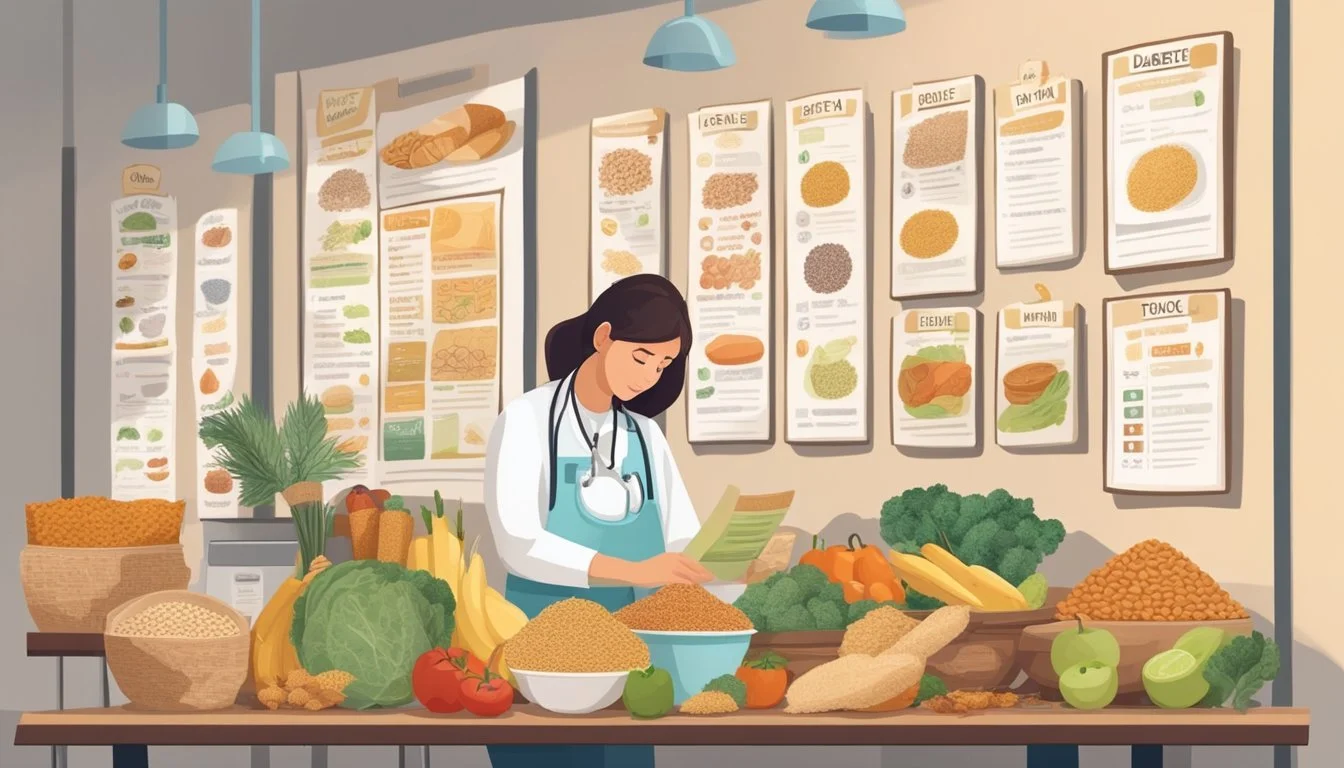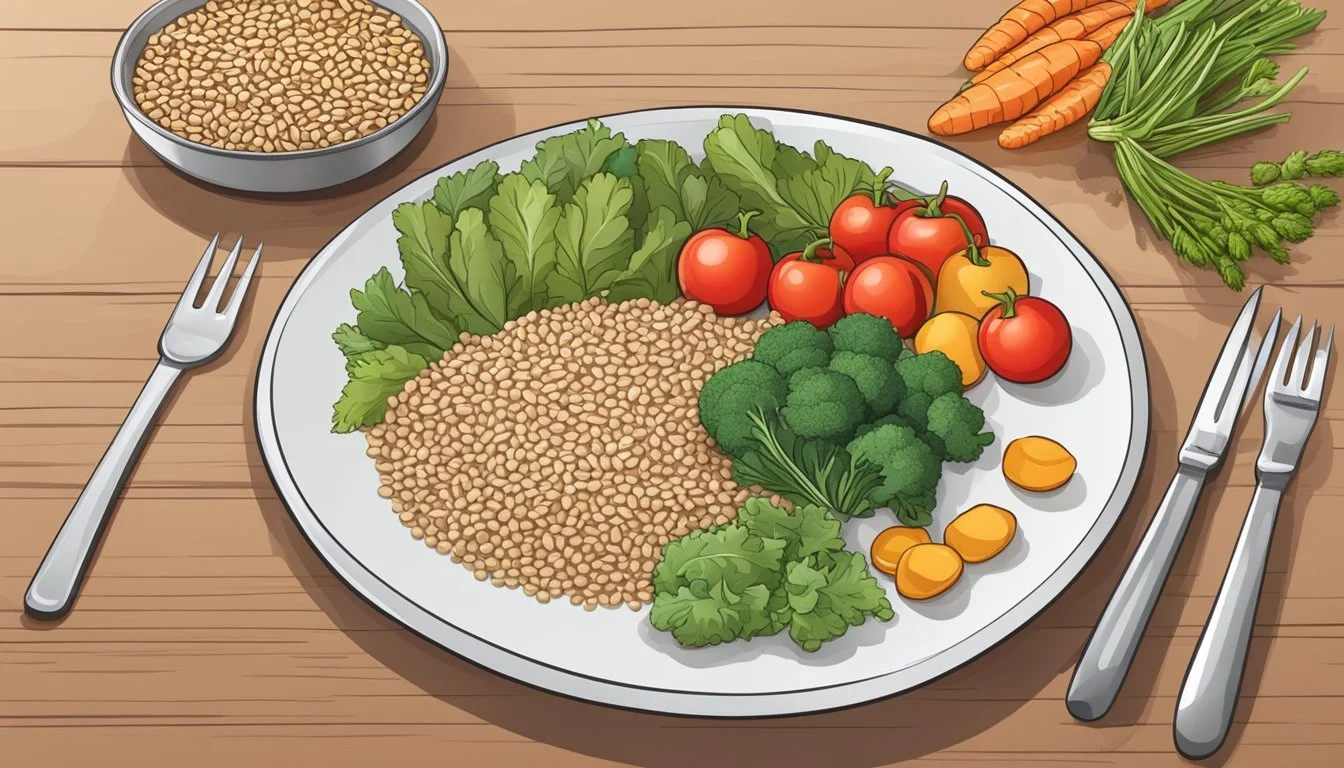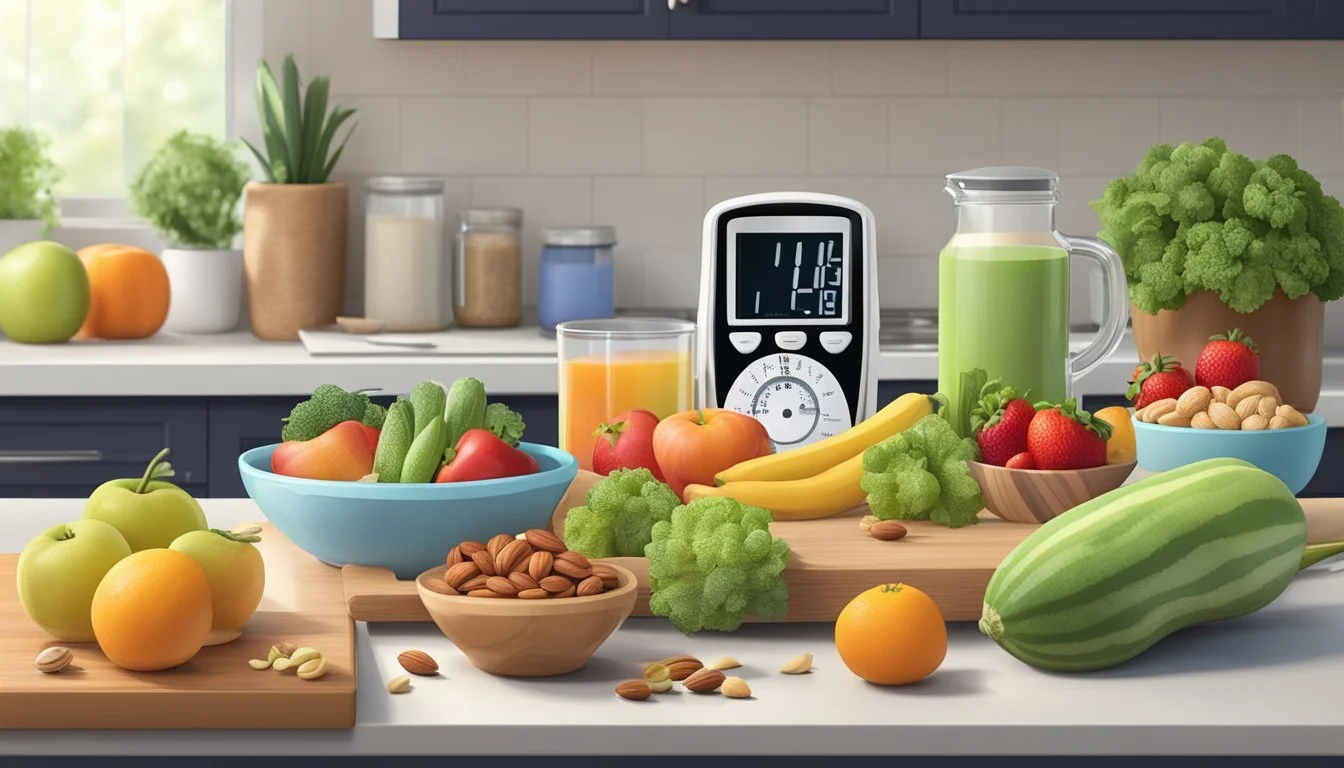Grain-Free Diets and Diabetes
Insights into Risks and Benefits
Grain-free diets have become a topic of interest among those looking to manage diabetes, as traditional dietary advice often centers on carbohydrate regulation. A grain-free diet eliminates all grains and grain-derived products, which means that wheat, barley, rye, and even whole grains are not consumed. This approach is thought to help stabilize blood sugar levels and reduce the risk of blood sugar spikes. For individuals with diabetes, maintaining consistent blood glucose levels is a critical component of managing their condition, and a grain-free diet can be an option to consider.
While a grain-free lifestyle is restrictive and can pose challenges, including ensuring a well-rounded nutrient intake, it also opens up a variety of alternative foods. Options such as legumes, tofu, tempeh (What wine goes well with tempeh?), and pseudocereals like quinoa and buckwheat can take the place of traditional grains. These foods provide important nutrients and can help maintain a balanced diet while avoiding grains.
Understanding the impact of a grain-free diet on diabetes management requires a look at both the benefits and potential drawbacks. The diet's efficacy for diabetes control must be backed by scientific evidence, ensuring that individuals can make informed decisions about their meals. It is essential to consult healthcare providers before making significant dietary changes, especially for those with diabetes, to ensure that nutritional needs continue to be met while working toward improved blood sugar control.
When it comes to managing diabetes, exploring the potential impact of grain-free diets is crucial for individuals seeking to prioritize their health. Understanding the influence of a grain-free diet on various aspects such as grain-free mental health, grain-free bone health, and grain-free autoimmune diseases is essential in making informed decisions.
Dispelling grain-free myth fact can help individuals navigate the wealth of information surrounding grain-free diets and make choices based on evidence-backed knowledge. By examining reputable sources and scientific research, individuals can gain a balanced understanding of the long-term pros and cons of a grain-free diet in relation to diabetes management.
Exploring the potential effects of a grain-free diet on grain-free endurance and grain-free fertility can provide valuable insights into the holistic impact of this dietary approach.
By considering the long-term implications of a grain-free diet for diabetes management, individuals can make informed choices, ensuring that their dietary approach aligns with their overall health and well-being goals. It is important for individuals to consult with healthcare professionals to determine the most suitable dietary plan for their specific needs.
Understanding Grain-Free Diets
When exploring dietary choices, particularly for those concerned with health conditions like diabetes, understanding the components and implications of a grain-free diet is essential. This section breaks down the fundamental aspects of a grain-free diet and distinguishes between common grains and pseudocereals.
Defining a Grain-Free Diet
A grain-free diet eliminates all grains, including wheat, barley, oats, rye, millet, and rice. This diet excludes foods made from these grains such as pasta, cereal, bread, and crackers. People may choose a grain-free diet for various reasons, such as managing celiac disease, allergies, or other health considerations. Without grains, the diet emphasizes a higher intake of vegetables, seeds, fruits, and protein sources to compensate for the lack of grain-derived fiber.
Grains vs. Pseudocereals
While traditional grains are members of the Poaceae, or grass family, pseudocereals are not true grains but are often consumed as such. Pseudocereals include quinoa, buckwheat, and amaranth. These are seeds of non-grass plants that share similar nutritional profiles to whole grains and are naturally gluten-free. Unlike grains, pseudocereals provide complete proteins, making them a favorable addition to a grain-free diet, particularly for those seeking to maintain a balanced nutrient intake.
Grain-Free Diet and Diabetes
When considering the relationship between a grain-free diet and diabetes management, it is pertinent to assess the diet's impact on blood sugar levels and its viability as part of a lifestyle approach to handling diabetes.
Impact on Blood Sugar Levels
Grains can influence blood sugar levels due to their carbohydrate content, which the body breaks down into sugar. A grain-free diet eliminates major sources of carbohydrates, potentially leading to more stable blood sugar levels for individuals with diabetes. For instance, by avoiding grains, a person might reduce their intake of easily digestible carbs that can cause rapid increases in blood sugar. However, it is essential to replace grains with other nutrient-dense foods to maintain a balanced diet and adequate fiber intake.
Managing Diabetes with a Grain-Free Diet
Managing diabetes with a grain-free diet can involve strategic food choices to ensure a well-rounded intake of nutrients while monitoring blood sugar levels. In place of grains, individuals might focus on consuming:
Proteins: Meat, fish, eggs, and dairy products can serve as primary protein sources.
Low-carb Vegetables: Leafy greens and cruciferous vegetables like broccoli and cauliflower offer vitamins, minerals, and fiber without significantly affecting blood sugar.
Healthy Fats: Avocado, nuts, seeds, and olive oil contribute essential fatty acids and can help satiety.
Legumes and Soy Products: Beans, lentils, tofu, and tempeh provide protein and other nutrients, although their carbohydrate content should be factored into the overall daily intake.
Consistent meal timing and portion control remain crucial elements in managing diabetes. One must consider the impact of all food choices on blood sugar and insulin requirements, and some individuals may benefit from including whole grains in their diet to aid in blood sugar management. Thus, it is recommended to consult healthcare providers to tailor the diet to individual needs, including any adaptations for insulin therapy.
Potential Benefits of Grain-Free Diets
Adopting a grain-free diet may offer various health advantages, ranging from weight management to improved digestive health and reduced inflammation, particularly for individuals with specific health conditions or dietary sensitivities.
Weight Management and Loss
A grain-free diet can facilitate weight loss and weight management for some individuals. By eliminating grains, one may inadvertently reduce calorie intake and lower carbohydrate consumption, which can lead to weight loss. This diet might be especially beneficial for those dealing with obesity as it encourages the consumption of more whole foods like vegetables, proteins, and healthy fats.
Digestive Health Improvements
People with certain digestive issues such as bloating, constipation, or inflammatory bowel disease might find relief by following a grain-free diet. The removal of grains, especially those containing gluten, can lead to fewer digestive symptoms and better overall digestive health.
Reduction in Inflammation
For those with autoimmune diseases or chronic inflammation, a grain-free diet may decrease inflammatory responses. Grains can contribute to inflammation for some individuals; thus, cutting them out might help manage and reduce the symptoms associated with inflammation, thereby potentially improving mental health and overall well-being.
Challenges of Grain-Free Diets
Choosing to adopt a grain-free diet can introduce several challenges related to nutrition and diet maintenance.
Nutritional Deficiencies
Grain-free diets may lead to nutritional deficiencies if not properly managed. Grains are a significant source of B vitamins, iron, magnesium, and trace minerals, which are essential for maintaining health. When eliminating grains, individuals may find it difficult to compensate for the loss of these nutrients.
B vitamins: Commonly found in whole grains, they are crucial for energy metabolism and nervous system function.
Iron: Integral for the production of hemoglobin, which transports oxygen in the blood.
Magnesium: Aids in muscle function and energy production.
Fiber: Whole grains are a rich source of dietary fiber, which is important for digestive health and can be lacking in grain-free diets.
It's essential for those on grain-free diets to seek alternative sources of these nutrients to avoid deficiencies. Consulting with a dietitian is advisable to ensure adequate intake of all necessary vitamins and minerals.
Difficulty Maintaining the Diet
Maintaining a grain-free diet can be challenging due to the pervasive presence of grains in modern diets. Many processed foods contain grain-based ingredients, which requires individuals to be vigilant when shopping and dining out.
Processed Foods: Refined grains are a staple in processed foods and avoiding them necessitates careful label reading.
Lifestyle Impact: A grain-free diet can feel restrictive and may impact social eating situations, leading to difficulties in adhering to the diet long-term.
People may find it stressful to consistently avoid grains, which could result in occasional lapses or abandoning the diet altogether. A dietitian can help in designing a sustainable grain-free meal plan that fits an individual's lifestyle, potentially increasing the likelihood of long-term success.
Grain-Free Diet and Gluten-Related Disorders
Grain-free diets are often adopted by individuals with gluten-related disorders, such as celiac disease and non-celiac gluten sensitivity. These diets eliminate grains to manage symptoms and prevent complications associated with gluten intake.
Celiac Disease and Non-Celiac Gluten Sensitivity
Celiac disease is an autoimmune condition wherein ingestion of gluten leads to damage of the small intestine. Nutrient malabsorption is a consequence, potentially leading to deficiencies unless a strict gluten-free diet is observed. Contrastingly, non-celiac gluten sensitivity presents similar symptoms but without the autoimmune intestinal damage. These individuals may also benefit from a gluten-free diet, which can include a variety of nutritious gluten-free food sources.
Associations with Other Autoimmune Diseases
Research suggests that individuals with celiac disease may have an increased risk of developing other autoimmune diseases, such as type 1 diabetes and thyroid disorders. A grain-free, gluten-free diet is crucial for managing celiac disease and may inadvertently influence the risk or symptomatology of associated autoimmune conditions, like fibromyalgia and endometriosis.
Mental Health Aspects
The role of diet in mental health is an emerging field of study. Gluten-related disorders, particularly celiac disease, have been linked with anxiety and depression. Adherence to a gluten-free diet can alleviate gastrointestinal symptoms and potentially improve related mental health challenges. However, it's important to consider the nutritional adequacy of a gluten-free diet to support overall mental well-being.
Alternative Food Choices on a Grain-Free Diet
When adopting a grain-free diet, individuals with diabetes need to choose substitute foods that maintain their nutritional balance while avoiding grains. Here are specific alternatives from various food groups.
Vegetables and Fruits
Vegetables are fundamental in a grain-free diet, offering essential vitamins, minerals, and fiber. Fruits also provide vitamins and sweetness without grain sources:
Leafy greens (e.g., spinach, kale)
Starchy vegetables like sweet potatoes are excellent for their nutrient density.
Broccoli, cauliflower, zucchini, and bell peppers
Fruits like berries, apples, and citrus fruits
Consider incorporating a variety of colors and types to ensure a broad spectrum of nutrients.
Protein and Dairy Alternatives
Protein sources in a grain-free diet are crucial for controlling blood sugar levels and maintaining muscle mass.
Meat such as beef, pork, and poultry
Fish and seafood are ideal for omega-3 fats.
Eggs are versatile and can be included in many meals.
Dairy choices include milk, cheese, and yogurt; choose low-sugar options where possible.
Nuts and seeds can be protein-rich snacks but also serve as good sources of healthy fats.
Healthy Fats and Legumes
Fats play an important role in satiety and should come from quality sources:
Avocados and olives offer monounsaturated fats.
Coconut oil and extra-virgin olive oil provide healthy cooking alternatives.
Legumes including beans and lentils are great for protein and fiber.
Nuts and seeds (almonds, walnuts, chia seeds, flaxseeds) are not only protein-rich but also high in fiber and healthy fats.
Preparing Meals and Snacks
When embarking on a grain-free diet, individuals with diabetes should focus on nutritious meals and snacks that maintain blood sugar levels while providing essential nutrients.
Grain-Free Breakfast Options
Avocado and Eggs: A combination of healthy fats from avocado and protein from eggs serves as a balanced start to the day.
Smoothie: A blend of spinach, berries, and a scoop of protein powder can create a quick and nutritious meal with minimal impact on blood sugar.
Lunch and Dinner Recipes
Grilled Chicken Salad: Topped with a mix of leafy greens, cherry tomatoes, and slivered almonds, dressed with olive oil and lemon juice.
Baked Salmon: Paired with roasted non-starchy vegetables such as broccoli and zucchini, providing key nutrients and healthy fats.
Snacks and Treats
Nuts: A modest handful of almonds, walnuts, or macadamia nuts offers a satiating blend of fats and protein.
Fruit: Small portions of fruits like berries or an apple can satisfy a sweet craving and provide dietary fiber.
Lifestyle Considerations
It’s imperative for individuals on grain-free diets, particularly those managing diabetes, to navigate daily life with a strategic approach to food choices. This includes being vigilant when dining out, attending social events, and shopping for groceries.
Dining Out and Social Events
When attending social gatherings or dining out, individuals should inquire about the ingredients used in dishes, as options like pizza and pastries commonly contain grains. It’s beneficial to look for items made with grain alternatives such as coconut flour, sorghum, or other gluten-free grains. Many restaurants now cater to special dietary requirements, providing detailed menus that highlight grain-free options.
Example of Dining Out Choices:
Starters: Salads without croutons, soups that are thickened without flour
Main Courses: Grilled proteins, veggie-based dishes with grain-free sides
Shopping and Reading Labels
Grocery shopping requires careful label reading to avoid processed foods that often contain grains as fillers or binding agents. Gluten-free labels don't necessarily mean grain-free, as some gluten-free products may contain grains like triticale or farro. When shopping for grain-free items, individuals should look for whole food ingredients and familiarize themselves with grain substitutes to make informed decisions.
Examples of Grain Substitutes for Label Reading:
Flours: Coconut flour, almond flour
Grains: Quinoa, buckwheat
By adhering to the described lifestyle considerations, individuals on grain-free diets can navigate social scenarios and shopping challenges efficiently, making conscious choices to support their dietary needs.
Conclusion
A grain-free diet involves eliminating grains from the diet, including wheat, rice, and corn. Individuals with diabetes may consider this diet with the anticipation that it could improve glycemic control. However, it is crucial to note that whole grains have been shown to have a beneficial impact on diabetes management.
Studies suggest that whole grains can improve insulin sensitivity and play a role in blood sugar regulation. Therefore, a balanced approach that includes whole grains may be preferable for most people with diabetes, rather than a strict grain-free regimen.
Before adopting any new diet, consultation with healthcare professionals is critical. They can provide guidance tailored to individual health needs and ensure that all nutritional requirements are met.
Here's a brief overview of points to consider:
Potential Benefits:
Grain-free diets may reduce inflammation in some individuals.
They can eliminate processed grains which are often high in sugars and refined carbohydrates.
Potential Risks:
May lead to a lack of essential nutrients.
Could result in a higher intake of saturated fats.
Whole Grains & Diabetes:
Inclusion of whole grains is generally recommended for their fiber, minerals, and potential to aid in blood sugar control.
Individuals should monitor their health and blood glucose levels regularly when making dietary changes. Personalized medical advice is always the best course of action to manage diabetes effectively.








